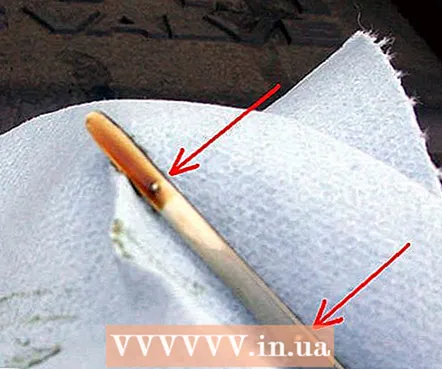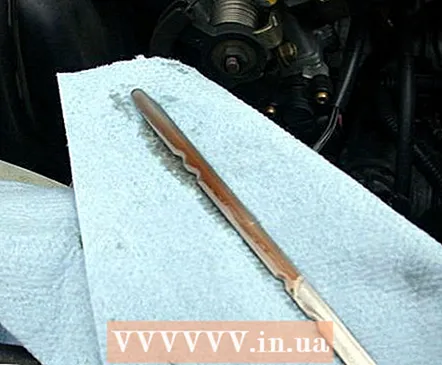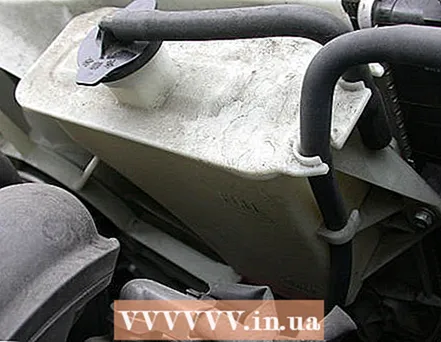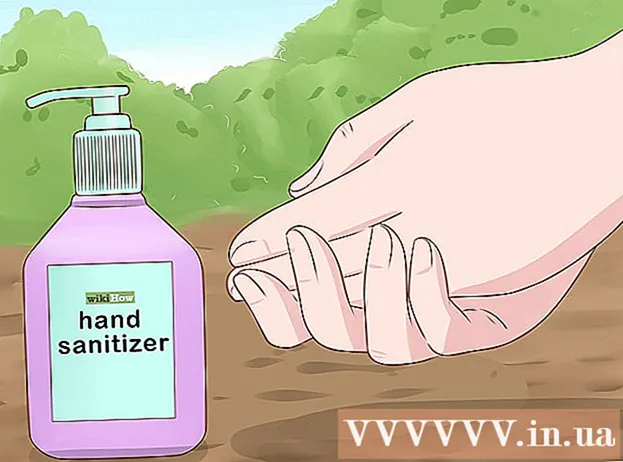Author:
Sara Rhodes
Date Of Creation:
10 February 2021
Update Date:
1 July 2024

Content
Your car is a big investment. Regularly checking the level of fluids in the car prevents breakdowns, mechanical damage and even possible accidents. Learn to check your car's fluid levels yourself and do it regularly. Once you get your hands on it, it won't be time-consuming to check.
Steps
 1 The car's manual tells you when you should check the fluid level, but this is only the minimum to maintain the warranty. Mark the last time you checked in your calendar, or just do it often.
1 The car's manual tells you when you should check the fluid level, but this is only the minimum to maintain the warranty. Mark the last time you checked in your calendar, or just do it often. - 2Park your vehicle on a flat, level surface and place it on the handbrake.
 3 Open the hood.
3 Open the hood. 4 Check engine oil. The engine oil level can be checked after the vehicle has cooled down for about an hour, when oil has drained from the longitudinal channels, cylinder head cavities, etc., to obtain accurate results. Find the dipstick (refer to the operating instructions). Slide your finger into the loop and pull out the dipstick, first loosening the latches that can hold it. Use a paper towel or rag to wipe it clean, for accurate results. Insert the dipstick into the hole and push it all the way. Pull it out for oil level information. Reinsert the dipstick when you're done.
4 Check engine oil. The engine oil level can be checked after the vehicle has cooled down for about an hour, when oil has drained from the longitudinal channels, cylinder head cavities, etc., to obtain accurate results. Find the dipstick (refer to the operating instructions). Slide your finger into the loop and pull out the dipstick, first loosening the latches that can hold it. Use a paper towel or rag to wipe it clean, for accurate results. Insert the dipstick into the hole and push it all the way. Pull it out for oil level information. Reinsert the dipstick when you're done. - The dipstick has marks for the permissible oil level (usually notches, indentations, or engraving). Double check the symbols you see in the instruction manual. If the oil level is too low, add the correct amount of engine oil before driving. If you have a new car, contact the service department from the dealership where you purchased the car, buy oil from them and ask them to show you how to top up. If you have an older car, go to an auto parts store, they will recommend oil and show you how to top up. Since some engines consume more oil than others, adding oil can become a common practice.

- Pay attention to the color of the oil. Clean engine oil should be clear and golden in color. Dirty engine oil is black or brown. If your engine oil is black, check your vehicle's maintenance records to find out when it was last changed. Darkened engine oil can also perform well, so rely on oil change intervals rather than oil color.
- The oil needs to be changed depending on both time and mileage. Check the operating instructions for the intervals at which the engine oil should be changed. Even if you have not traveled the number of kilometers listed there, plan to change the oil every 6 months. Even if you do not drive your car, the engine little gradually loses its properties and becomes less efficient. If you are on the road all the time, change the oil more often than indicated in the manual.
- Recurrent oil loss may indicate that you have a gasket leak or that your vehicle is consuming excessive oil. Watch for oil stains in the parking area of your car. Also look for traces of oil leaks on the engine, and if you notice them or the car continues to consume large amounts of oil, contact a mechanic to explain the problem.
- If the oil looks cloudy or foamy, the coolant may enter it, in which case the mechanic should check it. An inflated cylinder block gasket may indicate this and other serious damage.
- The dipstick has marks for the permissible oil level (usually notches, indentations, or engraving). Double check the symbols you see in the instruction manual. If the oil level is too low, add the correct amount of engine oil before driving. If you have a new car, contact the service department from the dealership where you purchased the car, buy oil from them and ask them to show you how to top up. If you have an older car, go to an auto parts store, they will recommend oil and show you how to top up. Since some engines consume more oil than others, adding oil can become a common practice.
 5 Check the transmission fluid (if you have an automatic transmission, see instructions for tips). This is usually done with the engine running and fully warm, in neutral or parked, depending on the model and manufacturer. A second probe is used for this. As in the case of the oil dipstick, find it, then pull it out (removing the latches that hold it), wipe it and insert it back until it stops, then you can pull it out to find out the liquid level. Look at the level between the two marks on the dipstick.
5 Check the transmission fluid (if you have an automatic transmission, see instructions for tips). This is usually done with the engine running and fully warm, in neutral or parked, depending on the model and manufacturer. A second probe is used for this. As in the case of the oil dipstick, find it, then pull it out (removing the latches that hold it), wipe it and insert it back until it stops, then you can pull it out to find out the liquid level. Look at the level between the two marks on the dipstick. - The transmission fluid is reddish because it is relatively fresh. Transmission fluid does not need to be changed as often as engine oil, but sometimes it does need to be changed. On new cars, the replacement interval can be up to 160,000 km, for more reliability check your manual. If it looks brown, black, burnt, or does not show that the fluid has ever been changed, consider replacing it.Transmission fluid lubricates the transmission, the drive train of your vehicle.

- The transmission fluid is reddish because it is relatively fresh. Transmission fluid does not need to be changed as often as engine oil, but sometimes it does need to be changed. On new cars, the replacement interval can be up to 160,000 km, for more reliability check your manual. If it looks brown, black, burnt, or does not show that the fluid has ever been changed, consider replacing it.Transmission fluid lubricates the transmission, the drive train of your vehicle.
 6 Check the brake fluid. Look in the manual or look around to find a plastic reservoir like the one in the picture labeled "brake fluid". If the tank looks like this, you can see the liquid level right through it. Wipe off any dirt on the outside of the tank for a better view. You can also shake the vehicle or its suspension slightly with your hips, arms, or knees to slightly shift the fluid level. If you still can't see it, remove the cover and look inside.
6 Check the brake fluid. Look in the manual or look around to find a plastic reservoir like the one in the picture labeled "brake fluid". If the tank looks like this, you can see the liquid level right through it. Wipe off any dirt on the outside of the tank for a better view. You can also shake the vehicle or its suspension slightly with your hips, arms, or knees to slightly shift the fluid level. If you still can't see it, remove the cover and look inside. - Cars must not consume brake fluid. A low brake fluid level may indicate a brake leak or a worn brake surface. If the brake fluid level is low, check the vehicle to find out the cause. A vehicle with a low level or leaking brake fluid may not apply the brakes.
 7 Check power steering fluid. Usually this is also a plastic tank. Look at the fluid level through the plastic reservoir, as you did with the brake fluid, and if necessary, remove the cap and add the appropriate amount of fluid to the required level. There can be two level markings on the reservoir, the first for a hot engine and the second for a cold one. Be guided by the designation that suits the current state of the car.
7 Check power steering fluid. Usually this is also a plastic tank. Look at the fluid level through the plastic reservoir, as you did with the brake fluid, and if necessary, remove the cap and add the appropriate amount of fluid to the required level. There can be two level markings on the reservoir, the first for a hot engine and the second for a cold one. Be guided by the designation that suits the current state of the car.  8 Check the coolant. Make sure the engine is cool, otherwise hot water may splash when you open the tank! The coolant reservoir should be located somewhere in the front, next to the radiator.
8 Check the coolant. Make sure the engine is cool, otherwise hot water may splash when you open the tank! The coolant reservoir should be located somewhere in the front, next to the radiator. - Antifreeze is used as a coolant for cars, not water. Antifreeze is a mixture that has a lower freezing point and generally a higher boiling point than water. If you need to top up antifreeze, purchase a bottle of the appropriate fluid.
- Read the label on the antifreeze. Some liquids need to be mixed 50-50 with water, others can be added immediately. Everything should be indicated on the label.
 9 Check the windscreen washer fluid.
9 Check the windscreen washer fluid.- Windshield washer fluid will not affect the performance of your car in any way, but it is what you use to clean your glass while driving.
- A liquid designed to clean glass from bugs and other road dirt is not expensive, although in extreme cases you can add a little water.
- There will be no harm to the vehicle if the wiper fluid level is low. You use it to clean glass while driving. Just fill the tank before the liquid runs out completely.
- If frost is expected outside, use a liquid that will not freeze at low temperatures. Low freezing wiper fluid is labeled accordingly.
- 10 Check tire pressure. It is not one of the fluids under the hood, but tire pressure is very important to vehicle performance and your safety. You should check it even more often than the engine fluid levels. At the same time, you can check the wear of the car tires.
Tips
- It's time to service your vehicle. When was the last time you changed your engine oil or serviced your car's systems? When is the next maintenance? Have you changed your tires recently?
- If you find a low fluid level, check it again after a short period of time and do it as often as possible. Also watch for fluid leaks from the machine. If the leak is confirmed, contact a service station.
- The standard transmission uses lubricant, which must also be checked, and this is done from the underside of the vehicle.
- A cold engine is an engine that has not been running for several hours. A hot or warm engine from a recently driven car.
- It is also a good idea to check the air filter frequently. They come in a variety of shapes and sizes and are installed in a variety of enclosures. It is not recommended to blow through the filter with a compressor, as this may damage it. The money spent on changing the filter will be returned to you as fuel savings.
- Manual transmission vehicles may also have a clutch master cylinder reservoir, which, like the brake master cylinder, may leak and need to be refilled.
- Take notes of what is special you notice, what you need to pay attention to. Also note yourself about fluid changes and maintenance.
- In rear wheel drive vehicles, also check the differential housing.
Warnings
- The brake fluid must be perfectly clean and free of moisture. It is therefore extremely important to thoroughly dry all surfaces before opening the brake fluid reservoir. The slightest impurities can interfere with the operation of the brake system. Also, do not use brake fluid that has been open for more than a month. An unsealed brake fluid container can absorb moisture from the air. Too much moisture in the brake system can lead to brake failure. If you are in doubt about how long the container has been open, purchase a new sealed brake fluid container.
- Do not check the engine oil level immediately after turning off the engine. Wait a while for the oil to drain from the engine into the reservoir. Otherwise, you may see a low oil level, which is actually not true, and you may be pouring too much of it.
- When refilling any vehicle fluids, make sure you use the correct type, otherwise you may damage your vehicle. If your vehicle requires a Mercon V transmission fluid and you filled in regular Mercon / Dexron "3", you could damage your transmission.
- Never pour automotive fluids onto the ground, gutter, or sink. Drain them into one bottle and ask your local auto shop or service station to recycle or dispose of them appropriately. Antifreeze attracts pets and is highly toxic.
- Avoid spilling car fluids on the body paint, some of which may damage the paintwork. If something does get on the surface of the car, clean the area well.



